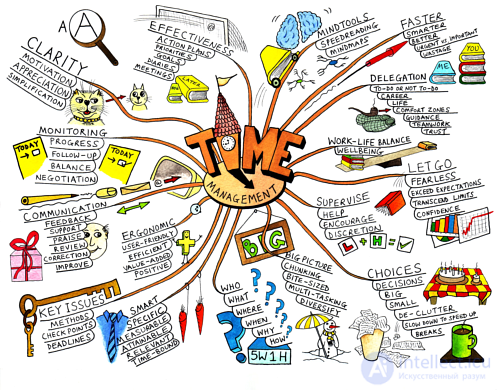
Source: MindTools
Mental maps are a visualization technique for thinking. Applications of mental maps are very diverse - for example, they can be used to fix, understand and remember the contents of a book or text, generate and write ideas, sort out a new topic for yourself, and prepare for making a decision.
How to draw a mental map: instructions
- Take a piece of paper and write in the center in one word the main theme, which is devoted to the map. Enclose it in a closed loop.
- From the central theme draw branches and place on them the keywords that are associated with it.
- Continue to expand the map, adding to the already drawn branches branches with keywords until the topic is exhausted.
Rules for working with mental maps
The technique seems intuitive, however, the following rules help to significantly improve its effectiveness.
- Write one word on one branch. This approach saves time and space and contributes to better readability of the card. It seems unusual at first, - you may be afraid that you will forget the rest of the words. In fact, you will not forget if you choose the most characteristic, vivid, remembered, “catchy” words as keywords.
- Place the sheet horizontally - this map will be more convenient to read.
- Write the keywords in block letters, in black, as clearly and clearly as possible.
- Place keywords directly on the lines representing their relationship. Do not enclose them in any framework. Write on each line only one keyword.
- The length of the line should be equal to the length of the word - do not make the line longer than the words. Do not interrupt the lines.
- Use different colors for the main branches so that they do not merge visually.
- Vary the size of the letters in the inscriptions and the thickness of the branches depending on the degree of distance from the main theme.
- Position the branches evenly - do not leave empty space and do not place the branches too tightly.
- Use pictures and symbols (at least - for the central theme, better - for all main branches).
- If you are drawing a complex map, it makes sense to first sketch a mini map with the main branches in order to determine the structure of the future map, since the choice of the main branches affects the organization and readability of the map.
Mental maps are a recording method that is alternative to text, lists, and diagrams (for example, “trees” or relationship diagrams). The main difference between mental maps from other ways of visualization is primarily the fact that mental cards activate memory . Lists, solid text, trees and diagrams are the same . Mental maps, on the contrary, use all possible ways to activate perception through diversity : different thickness of lines, different colors of branches, precisely selected keywords that are personally meaningful to you, the use of images and symbols. The technique of mental maps helps not only to organize and organize information, but also to better perceive, understand, remember and associate it.
When to use mental maps?
- In self-study . The study of any material can go faster if you fix the main ideas in the form of a mental map. Even if you are just reading a book, make a mental map and you will see how convenient it is to comprehend what you read (not to mention that this map can be very useful to you if you later want to quickly refresh the memory of the book).
- To create ideas . Write the task in the center and place on the branches of the idea or association, from them - the following associations, all the time asking yourself the question of how this can solve your problem.
- To sort out a new area . There are situations when you feel that the topic eludes understanding. Write it in the middle and place everything that relates to it outgoing from the center of the branches. When the map becomes large and chaotic, redraw it using several basic branches as structural ones.
- To present a large amount of information in a capacious form . You can do this for greater clarity, for example, during presentations, or for yourself (for example, so as not to forget something important during a speech).
Recommendations
Try to enjoy the very process of drawing a mental map. Make your card beautiful, because for this you need quite a bit - neat text in block letters, smooth lines of the same length as the keywords, different colors for the branches, so that they are not confused with each other, the simplest symbols-symbols denoting important for moments of you ... Of course, the degree of "beauty" may vary depending on the task, but do not regret the time, especially at the beginning of the development of technology. After a certain practice, it will leave quite a bit.
An interesting point in mental maps is that they are not only a means of visualizing the process of our thinking, but also at the same time diagnosing it. The very form of the card, the way it looks visually, says a lot about your attitude to the topic, about how clear you are to its individual aspects (represented by the main branches), about your way of perceiving this information.
We highly recommend starting with drawing mental cards with your hands. For beginners, it seems faster and easier to use computer programs, but this does not provide either mind mapping skills or the beneficial effect of organizing your own thinking in the process. The program for building mental maps will never allow you to draw an incorrectly composed map, and this is actually a problem, because, thinking for you, it makes it impossible for you to diagnose your thinking. The fact is that thanks to drawing with hands you can clearly see how and how effectively your thinking is organized on a topic.
Principles
If we summarize the above recommendations and rules, they are based on several principles:
- The mental map must activate perception and memory.
- The desire for greater clarity and readability of the card gives more awareness in thinking.
- The analysis of the map you have already drawn gives hints to the "device" of your thinking on the topic.
The idea of mental maps is based on the similarities between the image of the thinking process using the mental map and the device of the human brain: first, the mental map has, like the neuron, a radial structure, and secondly, physical thoughts are displayed as “trees” of biochemical impulses .
Related Links
- Mind Map Inspiration - Paul Foreman's blog on mental maps with great author examples.
- Mind42 - online service for creating mental maps
- MindMeister - an online service for creating mental maps (in the free version only 6 maps)
- Freemind is a free program for creating mental maps
- WikiMindMap is an interface to Wikipedia that turns a Wikipedia article into a mental map.
Related books
- In English: Tony Buzan. The mind map book
- In Russian: Tony Buzan. Intellect card
Examples
The examples below may seem to be too professional, but their main task is to demonstrate the very idea of mental maps, and not the artistic skill of the author.
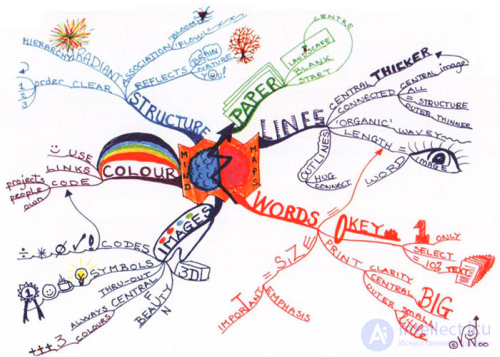
Mind mapping laws
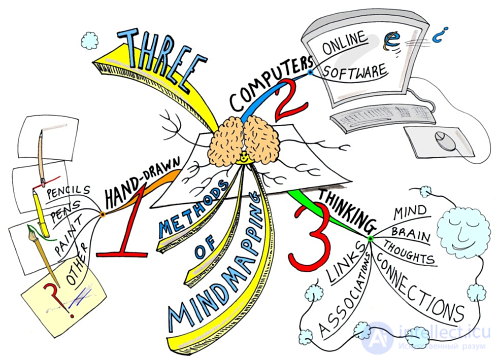
Three methods of mind mapping (Paul Forman)

50 inspirational ideas (Paul Forman)
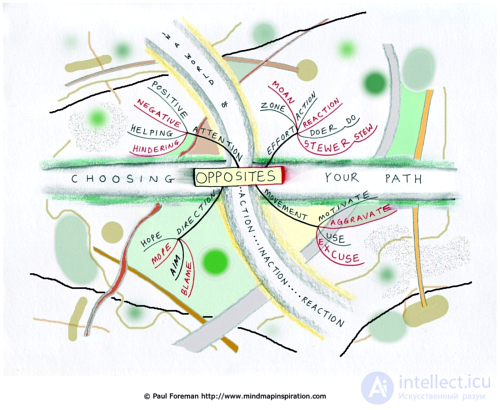
Choosing a path from opposites (Paul Forman)

Time Management (Mindtools)
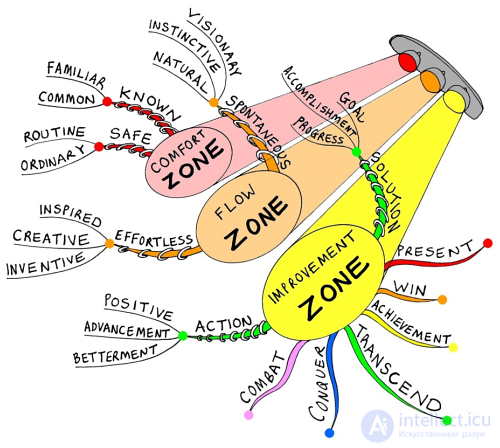
Outside the comfort zone (Paul Forman)
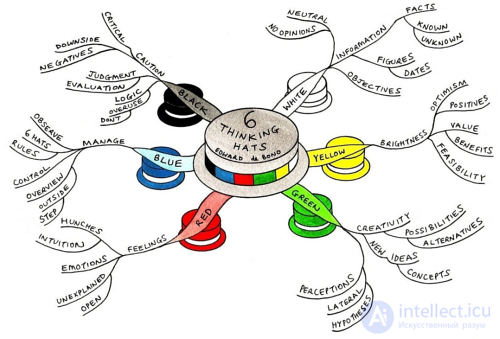
Six Thinking Hats (Paul Forman)








Comments
To leave a comment
General psychology
Terms: General psychology